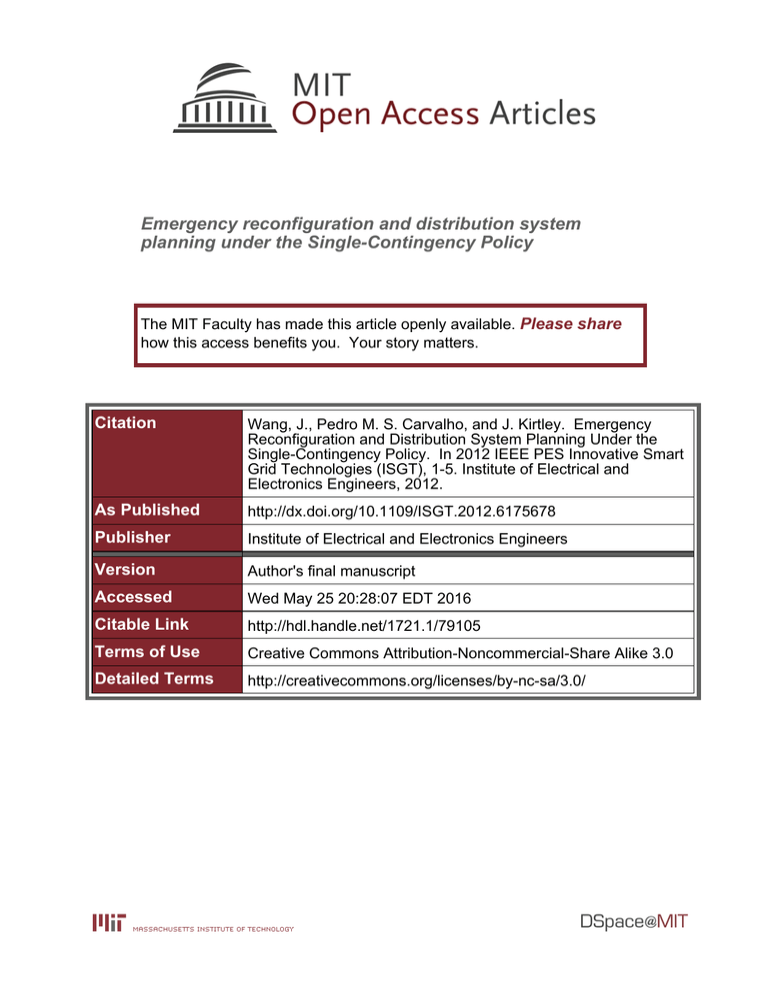Emergency reconfiguration and distribution system planning under the Single-Contingency Policy Please share
advertisement

Emergency reconfiguration and distribution system planning under the Single-Contingency Policy The MIT Faculty has made this article openly available. Please share how this access benefits you. Your story matters. Citation Wang, J., Pedro M. S. Carvalho, and J. Kirtley. Emergency Reconfiguration and Distribution System Planning Under the Single-Contingency Policy. In 2012 IEEE PES Innovative Smart Grid Technologies (ISGT), 1-5. Institute of Electrical and Electronics Engineers, 2012. As Published http://dx.doi.org/10.1109/ISGT.2012.6175678 Publisher Institute of Electrical and Electronics Engineers Version Author's final manuscript Accessed Wed May 25 20:28:07 EDT 2016 Citable Link http://hdl.handle.net/1721.1/79105 Terms of Use Creative Commons Attribution-Noncommercial-Share Alike 3.0 Detailed Terms http://creativecommons.org/licenses/by-nc-sa/3.0/ 1 Emergency Reconfiguration and Distribution System Planning under the Single-Contingency Policy J. Wang, Student Member, IEEE, Pedro M. S. Carvalho, and J. Kirtley, Fellow, IEEE Abstract-Emergency reconfiguration can improve distribution systems’ reliability by enabling load transfer among substations. Previous studies, although present its operation strategies, seldom explore emergency reconfiguration’s effects on distribution system planning. This paper explores how reconfiguration affects planning decisions and what benefits reconfiguration can bring to distribution system planning. For this purpose, two specific planning problems, planning substation capacity and allocating transformers, are studied under the Single-Contingency Policy (SCP). LP models are developed to find the optimal decisions in above problems. The main implications of this paper are: (1) enabling reconfigurable feeders can increase reliability with lower capital investment and operational cost when comparing to reinforcing transformer capacity; (2) the max-load of individual substation depends on its neighboring substations’ characteristics; (3) the reliability of a set of well interconnected substations depends on the max-shortage of one of its substations; and (4) allocating transformers according to distribution networks’ reconfiguration capability can improve distribution systems’ reliability. I. NOMENCLATURE The substations within the defined set are indexed as and the defined set is notated as . The substations set adjacent to substation and inside is notated as . The transformers installed in are indexed as . Load under substation ; Power transferred from substation to substation ; Unsatisfied load demand of substation ; Normal capacity of transformer ; Normal capacity of substation ; Emergency capacity of substation . Total overloading capacity of the remaining transformers after the largest transformer fails at substation ; Load transfer limit of the reconfigurable feeders connections between substation and ; . Maximum shortage of emergency This work was supported in part by the Masdar Institute of Science and Technology. J. Wang is with the Massachusetts Institute of Technology, Cambridge, MA 02139 USA (phone: +1 617 258 8494; fax: 617-258-6774; e-mail: jkwang@mit.edu). P. M. S. Carvalho is with the Instituto Superior Tecnico, Technical University of Lisbon, Portugal (phone: +351 218 417 706; e-mail: pcarvalho@ist.utl.pt ). J. Kirtley is with the Massachusetts Institute of Technology, Cambridge, MA 02139 USA (phone: +1 617 253 23574; e-mail: kirtley@mit.edu ). capacity of substation ; . Shortage of emergency capacity of substation for given load; . Operation margin of substation . II. INTRODUCTION T HE The reliability and efficiency of a distribution system are decided at the planning stage. Planning a distribution system falls into two stages: (1) allocating and sizing its equipments; and (2) planning its network topology. The Single-Contingency Policy (SCP) is often used in sizing the equipments. The policy permits one transformer failure within a substation; original load under the substation must be met at the time [1]. This requirement sets the load capacity of a substation as the substation’s total capacity of available transformers during a contingency. Emergency reconfiguration, which enables variation of distribution network topologies, makes the load capacity of an individual substation dependent of its neighboring substations’ characteristics. By switching on and off lines among substations, load can be transferred from the substation where a transformer fails to its adjacent substations. The concept of emergency reconfiguration was raised decades ago [2], and has been recently implemented in many places with the development of switch technologies [3-5]. Therefore, it is interesting to study how emergency reconfiguration affects decisions in distribution system planning and what benefits we can obtain by taking such decisions. In spite of many studies on distribution system planning and on operation strategies of emergency reconfiguration [3-7], few of them have considered the two topics together. [1] and [8] consider emergency reconfiguration in substation capacity planning, but they do not further explore the planning decisions’ differences nor quantify the benefits induced. This paper explores reconfiguration’s role in distribution system planning in two steps: (1) finding the upper bound of benefits that reconfiguration can provide to distribution system; and (2) optimizing resources utilization in distribution systems under limited reconfiguration capability. To address the two problems, Section II first presents the basic concepts in distribution system planning and emergency reconfiguration. Section III discusses planning substation capacity under unlimited load transfer capability. Section IV proposes a LP model of transformer allocation in a reconfigurable network with transfer limits. Finally, Section V concludes the study by stating several planning implications. 2 III. DISTRIBUTION SYSTEM PLANNING FUNDAMENTALS Planning a distribution system falls into two stages: (1) allocating and sizing its equipments; and (2) planning its network topology. This paper mainly focuses on the first stage. A distribution system consists of substations, feeders and, more recently, Distributed Generations (DG). For each substation, there are four major types of equipments: transformers, breakers, regulators and capacitor banks. Among all the equipments, transformers account for the majority of capital equipment investment with a range of about $100,000 to $ 800,000 per unit. The sum of the nameplate capacities of a substation’s transformers is referred to as the normal substation capacity. Conventionally, feeders have fixed topology, delivering power from substations to their loads. However, by enabling reconfiguration, feeders may become load balancing links between adjacent substations. In situations such as emergencies, temporary switching of feeders to those of adjacent substations allows a neighboring substation’s load to be shared. The amount of power which can be transferred through a feeder is limited by the feeder’s transfer capacity. A. Single-Contingency Policy The Single-Contingency Policy (SCP), which is also sometimes called N-1 criterion, is commonly used for sizing equipments’ capacities in a distribution system. Under SCP, the substation must meet its load, if failure occurs to either the largest transformer of its own or the largest transformer among all its adjacent substations. The latter case is evaluated when reconfiguration is allowed and load can be transferred between substations during an emergency. The substation planning analyst reviews the load profiles periodically to see if additional feeders, transformers or new substations are needed. Such assessment primarily involves the comparison of substation capacity and forecasted demand. In the event that a substation’s forecasted load exceeds the maximum load of the substation, the planner may be able to permanently reallocate the transformers or the excess load, depending on the available network topology and its reconfiguration possibilities, without necessitating new capital investments such as reinforcing/building feeders, purchasing transformers, or constructing new substations. The following sections will explore how to maximize substation’s load capacity and optimize transformation’s allocation, and furthermore, how reconfiguration influences the decisions and improves planning results. IV. PLANNING SUBSTATION LOAD CAPACITY This section presents the substation load capacity models with and without reconfiguration. Load capacity (or maximum loading) is studied under single and multiple substations cases. A larger load capacity indicates higher margin or less unsatisfied load, and thus higher reliability and better utilization of electrical equipments. We assume that there is a definable set of substations at given locations. The models aim at finding the maximum load capacity based on the SCP. A. Load Capacity under a Single Substation We determine the load capacity under a single substation based on SCP. If reconfiguration is not enabled in a distribution system, then for any substation , one must have: (1) which in turn gives . (2) For a distribution system with reconfiguration, researchers [1] have proposed a linear programming model to find the optimal load capacity under a single substation . By assuming there is no policy limiting the transfer among substations and the voltage drop is negligible, we simplify the LP problem proposed before into (3) (3) s.t. Transfer constraint for emergency at : ; Transfer constraint for adjacent to : ; Feeder transfer limits: where the transfer constraint for emergency at states the load at must be less than the emergency capacity of plus the power flow transferred from adjacent substations ; the transfer constraint for states the power flow transferred from to must be less than the operation margin at substation . Given that ’s adjacent loads are known as , the solution to (3) can be directly written as (4) Equation (4) shows that reconfiguration can raise the load capacity under a single substation by the amount in the sum operator. In other words, increasing reconfigurable feeders’ transfer limits of a substation, as an alternative to increase the emergency capacity of a substation, can improve the reliability of its supplying area. Since feeders’ capital investment is typically much less than that of transformers and extra transformers may induce larger no-load losses, reconfiguration is a more economic and efficient choice. B. Load Capacity under Multiple Substations To optimize the load capacity in a predefined set , we apply (3) to every substation . In addition, if assuming the transfer limits are very large, the total load in should satisfy: , 3 which means that the total load capacity in must be no greater than the emergency capacity of any plus the sum of the normal capacities of the other substations . Consequently, we have: max-load of any substation is determined by the largest shortage capacity in its neighborhood. TABLE II NUMERICAL CASE 2 Subs , (5) The benefits of reconfiguration are shown by (5). With the ability to sharing load, individual substations do not need to satisfy SCP strictly, as in (2) and (4). The load capacity of each substation gets to be a characteristic of neighborhood as a whole instead of being a local equipment limitation alone. B.1 Individual Flexibility and Overall Reliability: a Numerical Illustration Here, we illustrate that reconfiguration improves the individual flexibility and overall reliability of a predefined substation set . Consider the three-substation network shown in Table I and Fig. 1. TABLE I NUMERICAL CASE 1 36 12 72 24 63 48 In the above example, the total load (35+41+110 = 186) is the maximum value allowed by SCP, which can be verified by adding 1 unit of load to substation . However, this maximum load can be increased under different combinations of transformer: the load shown in the table below satisfy the SCP, while the total load in the neighborhood is higher (35+42+110=187). Subs Subs (30,30)=60 (10,65)=75 (60,60)=120 (30,30)=60 36 24 35 X 25 (5,50)=55 6 49 41+1 35+1 14-1 (60,60)=120 72 48 110 38 10 Substation A, B and C are interconnected with reconfigurable feeders of very large transfer limits. Each substation has two transformers of normal capacities listed in the braces under . 10 60 120 X 48 48 50 15 0 Fig. 1. Distribution system of Numerical Case 1. Substation A, B and C are interconnected with reconfigurable feeders of very large transfer limits. Each substation has two transformers of normal capacities listed in the braces under . In the network, normal capacity and emergency capacity are known. Without reconfiguration, the maximum load allowed for each substation must be calculated by (2), which are the same as . Under reconfiguration, allocate load can be allocated as shown in TABLE I without violating SCP. For example, the load capacity of substation is 120, which exceeds by 48. This shortage is shared among the neighborhood of all three substations through reconfigurable feeders. Moreover, the increment of total load capacity due to reconfiguration is calculated as: . B.2 A Common Pitfall: a Numerical Illustration A three-substation network in Table II illustrates a common pitfall in load capacity planning. Previous studies state that the max-load of a substation corresponds to the failure of the largest transformer of one of its neighbors [1], [8]. This statement is conflicting with Eq. (5), which claims that the (30,5)=35 (30,50)=80 (60,60)=120 6 36 72 29 44 48 35 41+1 110 29 6 38 0 38 10 In both above cases, the largest transformer is of capacity 60 and locates at substation . The increment of the total load capacity is due to the decrement of largest shortage of emergency capacity (from 49 to 48) in the neighborhood. Although this increment is trivial in this example, other combinations of transformers may result in obvious difference in practice. Furthermore, the result implies that each substation should be equipped with transformers of close ratings to reduce its shortage of emergency capacity and thus to improve the reliability of the overall neighborhood. V. ALLOCATING TRANSFORMERS Section III shows that the load capacity of a substation neighborhood is determined by the largest shortage of emergency capacity of any of its substations. Therefore, under a given network and a set of substations, optimally allocating transformers may improve the overall reliability of the area. This section proposes a LP model to find the optimal transformer allocation under SCP. The objective is to minimize the unsatisfied load, and consequently, maximize the reliability in the area. That is: (6) where and are the decision variables. equals to 1 if transformer is allocated at substation , and equals to 0 otherwise. The constraints of the LP model are: Logic Constraints: Each transformer must be allocated at most once: ; (7) ; (8) 4 Normal Capacity Constraint: The normal capacity of substation is the sum of normal capacity of the transformers allocated at : ; (9) And the load supplied by substation must be below the ’s normal capacity: ; (10) Emergency Capacity Constraint: The emergency capacity is the normal capacity of substation minus that of its largest transformer, operating at overloading factor. ; (11) Emergency transfer constraints: Under the largest transformer failure, the load that substation supplies must be less than ’s emergency capacity plus the available power flow that can be transferred from its adjacent substations : Fig. 2. Distribution system of Numerical Case 3. Substation A, C and B, C are interconnected with reconfigurable feeders of very large transfer limits. Transfer limits between A and B is . Each substation has two transformers of normal capacities listed in the braces under . The loads in the network satisfy the SCP when there is no transfer limits on the interconnecting feeders. However, because the power transferred between substations and is limited under 30, during an emergency, the supply shortage of load at substation (= 48) can not be transferred to other substations due to the congestion. A similar problem happens to substation , too. This fact in turn reduces the load capacity of substation to 42 and load capacity of substation to 117. Now we reallocate transformers by applying the proposed model. The results are listed in the table below: Subs ; (12) When the largest transformer of ’s adjacent substation fails, the power flow transferred from to must be less than the operation margin at : ; (13) In addition, power flow transferred between substations and must be less than feeders’ limits: ; (14) A. Utilization of Reconfigurable Feeders: a Numerical Illustration The example in Table III illustrates that the optimal allocation of transformers can improved reliability in a given network. TABLE II NUMERICAL CASE 3 Subs (30,30)=60 (10,65)=75 (60,60)=120 36 12 72 24 63 48 10 60 120 X 48 48 50 15 0 (30,10)=40 (30,65)=95 (60,60)=120 12 36 72 28 59 48 10 60 120 X 24 48 30 35 0 The table above shows that with a better allocation of transformers the load capacity in a network can be increased without violating feeders’ transfer limits, and consequently, the reliability is improved. VI. CONCLUSION The reliability and operation efficiency of a distribution system are decided at the planning stage. Emergency reconfiguration, which enables load transfer among substations, can improve distribution systems’ reliability with less capital investment and reduce operation loss which would be induced from extra transformer capacity . This paper illustrates how reconfiguration can affect decisions and what benefits it can bring to distribution system planning. For this purpose, two specific planning problems are studied under the Single-Contingency Policy (SCP): planning substation capacity and allocating transformers. LP models are developed to find the optimal decisions for the above problems. The main implications of this paper are: (1) enabling reconfigurable feeders can increase reliability with lower capital investment and operational cost when comparing to reinforcing transformer capacity; (2) the max-load of individual substation depends on its neighboring substations’ characteristics; (3) the reliability of a set of well interconnected substations depends on the max-shortage of one of its substations; and (4) allocating transformers according to distribution networks’ reconfiguration capability 5 can improve distribution systems’ reliability. Implications (2) and (3) disprove the statements in previous works [1], [8]. VII. ACKNOWLEDGMENT The following is an example of an acknowledgment. (Please note that financial support should be acknowledged in the unnumbered footnote on the title page.) The authors gratefully acknowledge the contributions of I. X. Austan, A. H. Burgmeyer, C. J. Essel, and S. H. Gold for their work on the original version of this document. VIII. REFERENCES [1] [2] [3] [4] [5] [6] [7] [8] L.C. Leung, S.K. Khator, and J. Pence, “Planning substation capacity under the single-contingency scenario,” IEEE Trans. on Power Systems, vol. 3, pp 1442-1447, Oct. 1995. M.E. Baran, and F.F. Wu, “Network reconfiguration in distribution systems for loss reduction and load balancing,” IEEE Trans on Power Delivery, vol. 2, pp. 1401-1407, Apr. 1989. M.A. Kashem, V. Ganapathy, and G.B. Jasmon, “Network reconfiguration for load balancing in distribution networks,” IEE Proceedings for generation, transmission and distribution, vol. 146(6), 1999. D. Staszesky, D. Craig, and C. Befus, “Advanced feeder automation is here,” IEEE power & energy magazine, Sept/Oct 2005. J. Zhu, “Optimal reconfiguration of electrical distribution network,” in Optimization of power system operation, Institute of Electrical and Electronics Engineers, 2009, p. 503-543. [Online]. Available: http://onlinelibrary.wiley.com/doi/10.1002/9780470466971.ch12/summa ry S.K. Goswami, “Distribution system planning using branch exchange technique,”. IEEE Trans. on Power Systems, vol. 2, pp. 718-723, Dec. 1997. S. Jonnavithula, and R. Billinton, “Minimum cost analysis of feeder routing in distribution system planning,” IEEE Trans. on Power Systems, vol. 4, pp. 1935-1940, Nov. 1996. L.C. Leung, S.K. Khator, and J. Ponce, “Optimal transformer allocation under single-contingency,” IEEE Trans. on Power Systems, vol. 11, pp. 1046-1051, May 1996. Jiankang Wang (S’ 2008) became a student member of IEEE in 2008. She received a S.M. in EECS from MIT, Cambridge, MA in 2009. Currently, she is a PhD student at MIT. Her research interests include electricity market analysis and design with demand response, and energy efficiency of smart grid. Pedro M. S. Carvalho received the Electrical and Computer Engineering degree, the M.Sc. degree, and the Ph.D. degree from the Instituto Superior Tecnico (IST), Technical University of Lisbon, Lisbon, Portugal, in 1992, 1994, and 1999, respectively. Since 1992, he has been with the Department of Electrical Engineering and Computers, IST, where he is currently an Associate Professor. James L. Kirtley Jr. (S’69-M’71-SM’80-F’91) Received the S.B. and S.M degrees in 1968, EE in 1969 and Ph.D. in 1971 from MIT, all in Electrical Engineering. He has been with the MIT as a member of the faculty since 1971, now serving as Professor of EECS. He has also worked for General Electric Company as Engineer, Satcon Technology Corporation as Vice President, General Manager and Chief Scientist, and the Swiss Federal Institute of Technology as Gastdozent. Dr. Kirtley has served as Editor in Chief of the IEEE Transactions on Energy Conversion and is on the editorial board of Electric Power Components and Systems. He is a member of the National Academy of Engineering and received the IEEE Third Millenium Medal in 2000 and the Nikola Tesla award in 2002. He is a registered professional engineer in Massachusetts.






